2011 INFINITI QX56 service
[x] Cancel search: servicePage 4460 of 5598
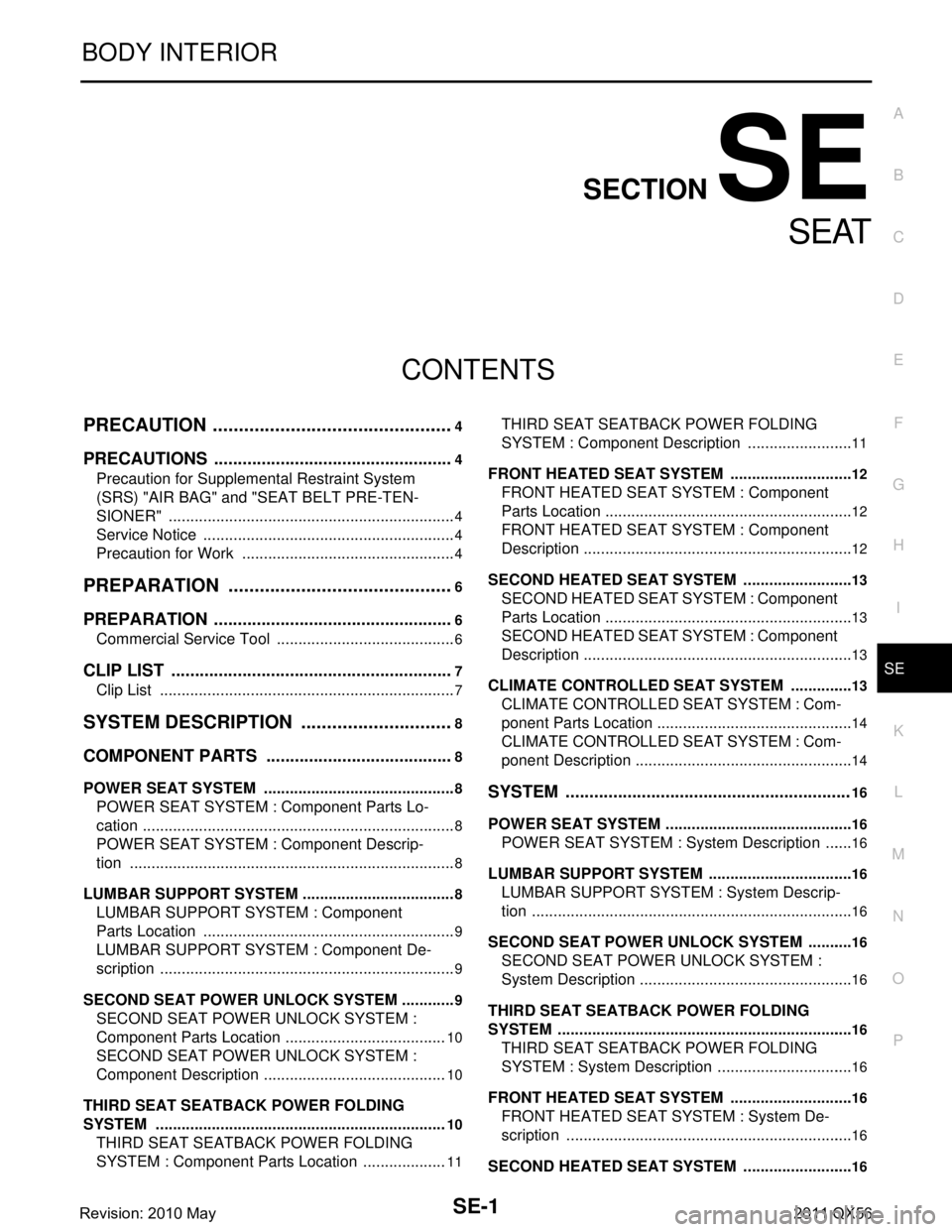
SE-1
BODY INTERIOR
C
DE
F
G H
I
K L
M
SECTION SE
A
B
SE
N
O P
CONTENTS
SEAT
PRECAUTION ................ ...............................4
PRECAUTIONS .............................................. .....4
Precaution for Supplemental Restraint System
(SRS) "AIR BAG" and "SEAT BELT PRE-TEN-
SIONER" ............................................................. ......
4
Service Notice ...........................................................4
Precaution for Work ..................................................4
PREPARATION ............................................6
PREPARATION .............................................. .....6
Commercial Service Tool .................................... ......6
CLIP LIST ............................................................7
Clip List ............................................................... ......7
SYSTEM DESCRIPTION ..............................8
COMPONENT PARTS ................................... .....8
POWER SEAT SYSTEM .............................................8
POWER SEAT SYSTEM : Component Parts Lo-
cation ................................................................... ......
8
POWER SEAT SYSTEM : Component Descrip-
tion ...................................................................... ......
8
LUMBAR SUPPORT SYSTEM .............................. ......8
LUMBAR SUPPORT SYSTEM : Component
Parts Location ..................................................... ......
9
LUMBAR SUPPORT SYSTEM : Component De-
scription .....................................................................
9
SECOND SEAT POWER UNLOCK SYSTEM ....... ......9
SECOND SEAT POWER UNLOCK SYSTEM :
Component Parts Location ......................................
10
SECOND SEAT POWER UNLOCK SYSTEM :
Component Description ...........................................
10
THIRD SEAT SEATBACK POWER FOLDING
SYSTEM ................................................................ ....
10
THIRD SEAT SEATBACK POWER FOLDING
SYSTEM : Component Parts Location ....................
11
THIRD SEAT SEATBACK POWER FOLDING
SYSTEM : Component Description ..................... ....
11
FRONT HEATED SEAT SYSTEM ......................... ....12
FRONT HEATED SEAT SYSTEM : Component
Parts Location ..........................................................
12
FRONT HEATED SEAT SYSTEM : Component
Description ...............................................................
12
SECOND HEATED SEAT SYSTEM ...................... ....13
SECOND HEATED SEAT SYSTEM : Component
Parts Location ..........................................................
13
SECOND HEATED SEAT SYSTEM : Component
Description ...............................................................
13
CLIMATE CONTROLLED SEAT SYSTEM ...............13
CLIMATE CONTROLLED SEAT SYSTEM : Com-
ponent Parts Location .......................................... ....
14
CLIMATE CONTROLLED SEAT SYSTEM : Com-
ponent Description ...................................................
14
SYSTEM ............................................................16
POWER SEAT SYSTEM ....... .....................................16
POWER SEAT SYSTEM : Syst em Description .......16
LUMBAR SUPPORT SYSTEM .............................. ....16
LUMBAR SUPPORT SYSTEM : System Descrip-
tion ...........................................................................
16
SECOND SEAT POWER UNLOCK SYSTEM ...........16
SECOND SEAT POWER UNLOCK SYSTEM :
System Description .............................................. ....
16
THIRD SEAT SEATBACK POWER FOLDING
SYSTEM .....................................................................
16
THIRD SEAT SEATBACK POWER FOLDING
SYSTEM : System Description ............................ ....
16
FRONT HEATED SEAT SYSTEM ......................... ....16
FRONT HEATED SEAT SYSTEM : System De-
scription ...................................................................
16
SECOND HEATED SEAT SYSTEM ...................... ....16
Revision: 2010 May2011 QX56
Page 4463 of 5598

SE-4
< PRECAUTION >
PRECAUTIONS
PRECAUTION
PRECAUTIONS
Precaution for Supplemental Restraint System (SRS) "AIR BAG" and "SEAT BELT
PRE-TENSIONER"
INFOID:0000000006237842
The Supplemental Restraint System such as “A IR BAG” and “SEAT BELT PRE-TENSIONER”, used along
with a front seat belt, helps to reduce the risk or severi ty of injury to the driver and front passenger for certain
types of collision. This system includes seat belt switch inputs and dual stage front air bag modules. The SRS
system uses the seat belt switches to determine the front air bag deployment, and may only deploy one front
air bag, depending on the severity of a collision and w hether the front occupants are belted or unbelted.
Information necessary to service the system safely is included in the “SRS AIR BAG” and “SEAT BELT” of this
Service Manual.
WARNING:
• To avoid rendering the SRS inopera tive, which could increase the risk of personal injury or death in
the event of a collision that would result in air bag inflation, all maintenance must be performed by
an authorized NISS AN/INFINITI dealer.
Improper maintenance, including in correct removal and installation of the SRS, can lead to personal
injury caused by unintent ional activation of the system. For re moval of Spiral Cable and Air Bag
Module, see the “SRS AIR BAG”.
Do not use electrical test equipmen t on any circuit related to the SRS unless instructed to in this
Service Manual. SRS wiring harnesses can be identi fied by yellow and/or orange harnesses or har-
ness connectors.
PRECAUTIONS WHEN USING POWER TOOLS (AIR OR ELECTRIC) AND HAMMERS
WARNING:
When working near the Air Bag Diagnosis Sensor Unit or other Air Bag System sensors with the ignition ON or engine running, DO NOT use air or electric power tools or strike near the sensor(s)
with a hammer. Heavy vibration could activate the sensor(s) and deploy the air bag(s), possibly
causing serious injury.
When using air or electric power tools or hammers , always switch the ignition OFF, disconnect the
battery, and wait at least 3 minu tes before performing any service.
Service NoticeINFOID:0000000006217352
When removing or installing various parts, place a cloth or padding onto the vehicle body to prevent
scratches.
Handle trim, molding, instruments, grille, etc. carefull y during removing or installing. Be careful not to oil or
damage them.
Apply sealing compound where necessary when installing parts.
When applying sealing compound, be careful that t he sealing compound never protrudes from parts.
When replacing any metal parts (for example body outer panel, members, etc.), always take rust prevention
measures.
Precaution for WorkINFOID:0000000006217353
When removing or disassembling each component, be careful not to damage or deform it. If a component
may be subject to interference, al ways protect it with a shop cloth.
When removing (disengaging) components with a screwdriver or similar tool, always wrap the component
with a shop cloth or vinyl tape to protect it.
Protect the removed parts with a shop cloth and keep them.
Replace a deformed or damaged clip.
If a part is specified as a non-reusable part, always replace it with new one.
Always tighten bolts and nuts securely to the specified torque.
After reinstallation is complete, always check that each part works normally.
Follow the steps below to clean components.
- Water soluble foul: Dip a soft cloth into lukewarm water, and wring the water out of the cloth to wipe the fouled area.
Then rub with a soft and dry cloth.
Revision: 2010 May2011 QX56
Page 4465 of 5598
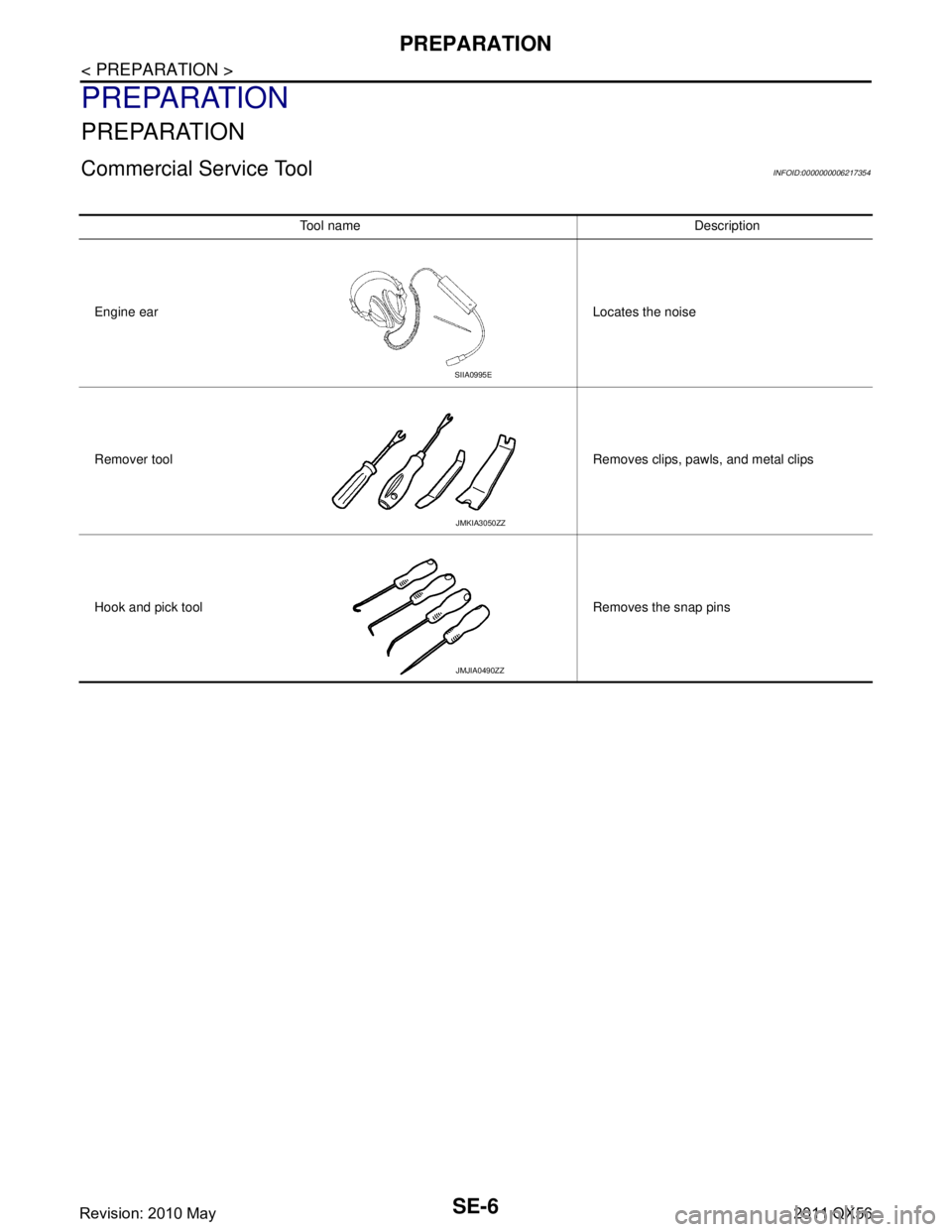
SE-6
< PREPARATION >
PREPARATION
PREPARATION
PREPARATION
Commercial Service ToolINFOID:0000000006217354
Tool name Description
Engine ear Locates the noise
Remover tool Removes clips, pawls, and metal clips
Hook and pick tool Removes the snap pins
SIIA0995E
JMKIA3050ZZ
JMJIA0490ZZ
Revision: 2010 May2011 QX56
Page 4558 of 5598
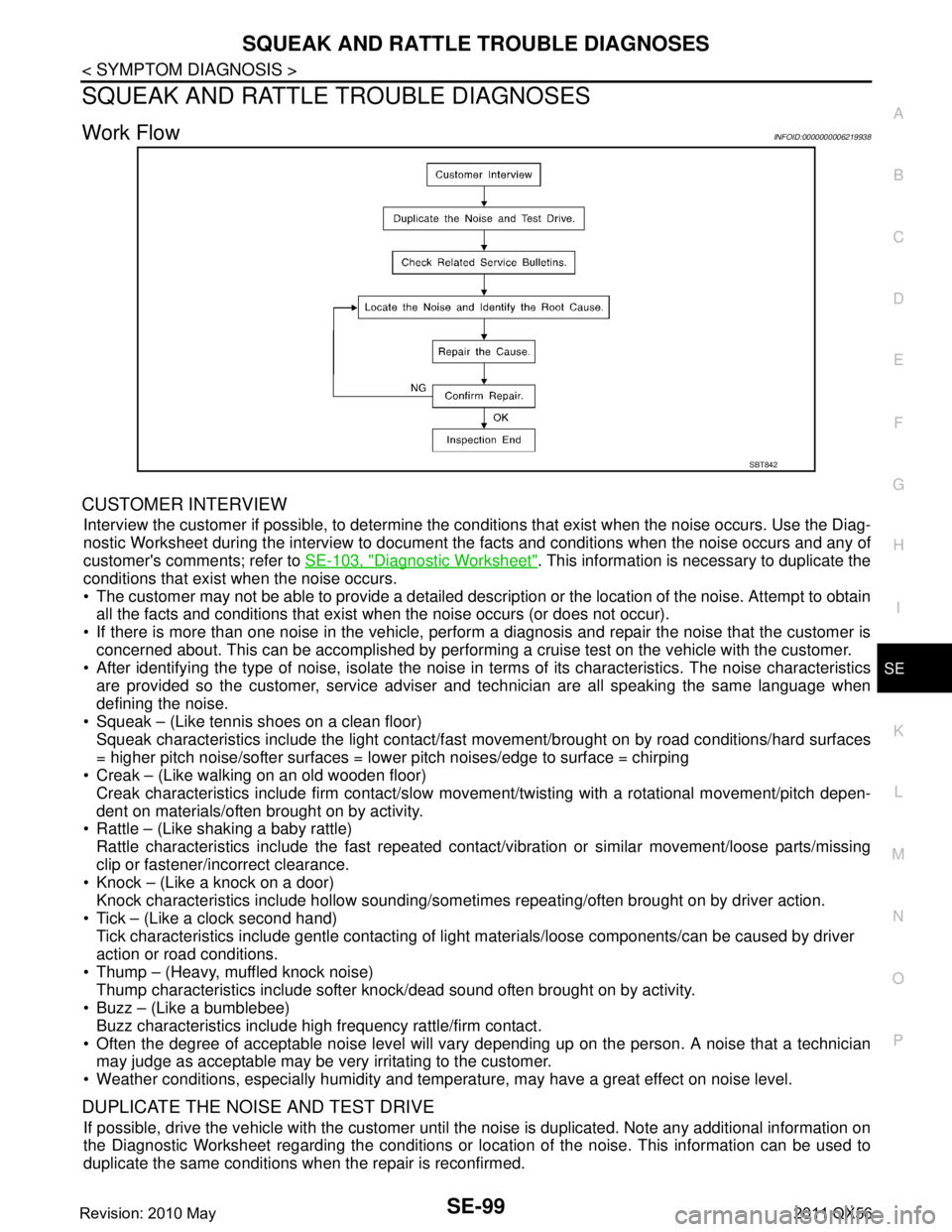
SQUEAK AND RATTLE TROUBLE DIAGNOSESSE-99
< SYMPTOM DIAGNOSIS >
C
DE
F
G H
I
K L
M A
B
SE
N
O P
SQUEAK AND RATTLE TROUBLE DIAGNOSES
Work FlowINFOID:0000000006219938
CUSTOMER INTERVIEW
Interview the customer if possible, to determine the conditions that exist when the noise occurs. Use the Diag-
nostic Worksheet during the interview to document t he facts and conditions when the noise occurs and any of
customer's comments; refer to SE-103, "
Diagnostic Worksheet". This information is necessary to duplicate the
conditions that exist when the noise occurs.
The customer may not be able to provide a detailed description or the location of the noise. Attempt to obtain all the facts and conditions that exist when the noise occurs (or does not occur).
If there is more than one noise in the vehicle, perform a diagnosis and repair the noise that the customer is
concerned about. This can be accomplished by performing a cruise test on the vehicle with the customer.
After identifying the type of noise, isolate the noise in terms of its characteristics. The noise characteristics
are provided so the customer, service adviser and technician are all speaking the same language when
defining the noise.
Squeak – (Like tennis shoes on a clean floor)
Squeak characteristics include the light contact/fast movement/brought on by road conditions/hard surfaces
= higher pitch noise/softer surfaces = lower pitch noises/edge to surface = chirping
Creak – (Like walking on an old wooden floor)
Creak characteristics include firm contact/slow mo vement/twisting with a rotational movement/pitch depen-
dent on materials/often brought on by activity.
Rattle – (Like shaking a baby rattle)
Rattle characteristics include the fast repeated contac t/vibration or similar movement/loose parts/missing
clip or fastener/incorrect clearance.
Knock – (Like a knock on a door)
Knock characteristics include hollow sounding/someti mes repeating/often brought on by driver action.
Tick – (Like a clock second hand) Tick characteristics include gentle contacting of li ght materials/loose components/can be caused by driver
action or road conditions.
Thump – (Heavy, muffled knock noise) Thump characteristics include softer k nock/dead sound often brought on by activity.
Buzz – (Like a bumblebee)
Buzz characteristics include high frequency rattle/firm contact.
Often the degree of acceptable noise level will vary depending up on the person. A noise that a technician may judge as acceptable may be very irritating to the customer.
Weather conditions, especially humidity and temperat ure, may have a great effect on noise level.
DUPLICATE THE NOISE AND TEST DRIVE
If possible, drive the vehicle with the customer until the noise is duplicated. Note any additional information on
the Diagnostic Worksheet regarding the conditions or lo cation of the noise. This information can be used to
duplicate the same conditions when the repair is reconfirmed.
SBT842
Revision: 2010 May2011 QX56
Page 4559 of 5598
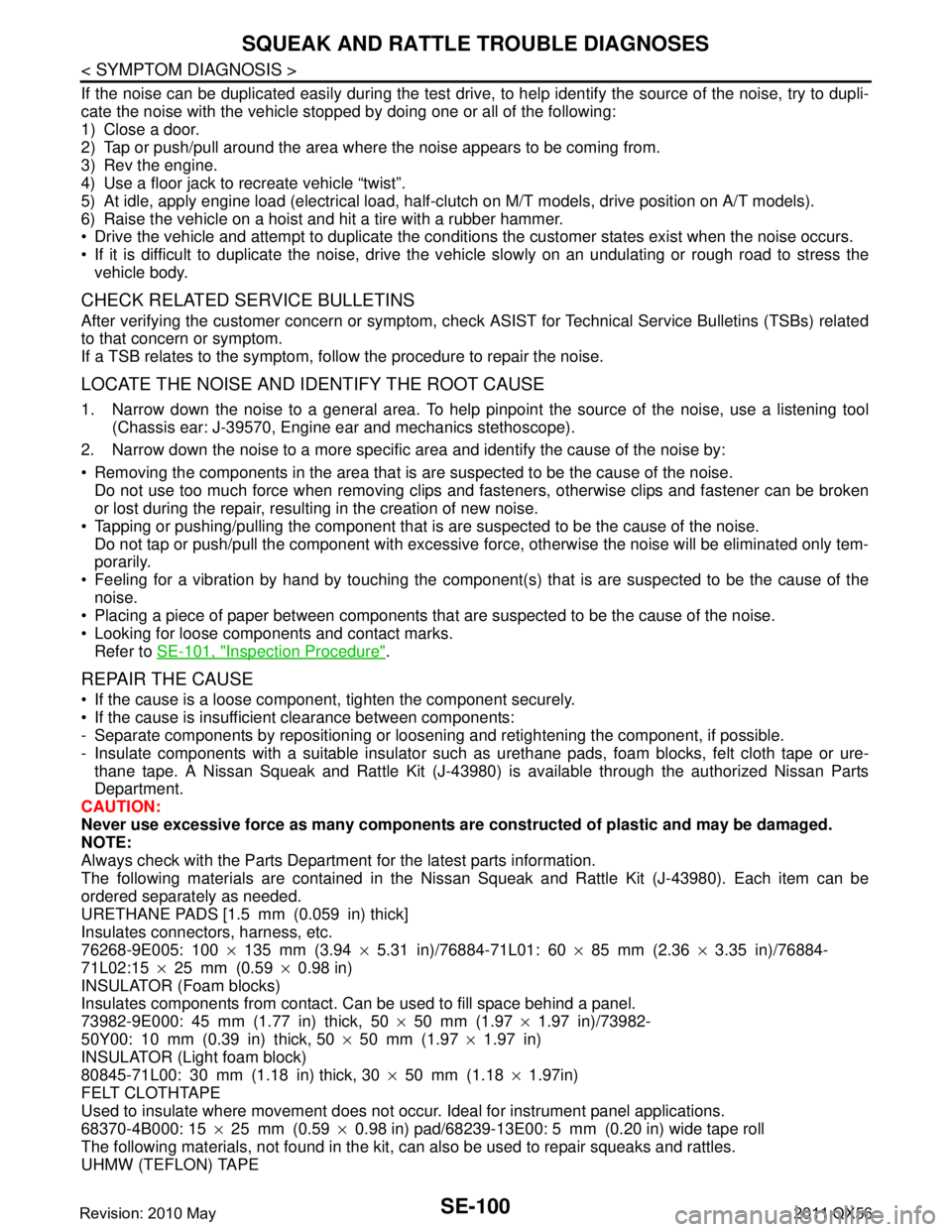
SE-100
< SYMPTOM DIAGNOSIS >
SQUEAK AND RATTLE TROUBLE DIAGNOSES
If the noise can be duplicated easily during the test drive, to help identify the source of the noise, try to dupli-
cate the noise with the vehicle stopped by doing one or all of the following:
1) Close a door.
2) Tap or push/pull around the area where the noise appears to be coming from.
3) Rev the engine.
4) Use a floor jack to recreate vehicle “twist”.
5) At idle, apply engine load (electrical load, half-cl utch on M/T models, drive position on A/T models).
6) Raise the vehicle on a hoist and hit a tire with a rubber hammer.
Drive the vehicle and attempt to duplicate the conditions the customer states exist when the noise occurs.
If it is difficult to duplicate the noise, drive the v ehicle slowly on an undulating or rough road to stress the
vehicle body.
CHECK RELATED SERVICE BULLETINS
After verifying the customer concern or symptom, chec k ASIST for Technical Service Bulletins (TSBs) related
to that concern or symptom.
If a TSB relates to the symptom, follo w the procedure to repair the noise.
LOCATE THE NOISE AND IDENTIFY THE ROOT CAUSE
1. Narrow down the noise to a general area. To help pi npoint the source of the noise, use a listening tool
(Chassis ear: J-39570, Engine ear and mechanics stethoscope).
2. Narrow down the noise to a more specific area and identify the cause of the noise by:
Removing the components in the area that is are suspected to be the cause of the noise.
Do not use too much force when removing clips and fasteners, otherwise clips and fastener can be broken
or lost during the repair, resulting in the creation of new noise.
Tapping or pushing/pulling the component that is are suspected to be the cause of the noise.
Do not tap or push/pull the component with excessive force, otherwise the noise will be eliminated only tem-
porarily.
Feeling for a vibration by hand by touching the component (s) that is are suspected to be the cause of the
noise.
Placing a piece of paper between components that are suspected to be the cause of the noise.
Looking for loose components and contact marks. Refer to SE-101, "
Inspection Procedure".
REPAIR THE CAUSE
If the cause is a loose component, tighten the component securely.
If the cause is insufficient clearance between components:
- Separate components by repositioning or loos ening and retightening the component, if possible.
- Insulate components with a suitable insulator such as urethane pads, foam blocks, felt cloth tape or ure-
thane tape. A Nissan Squeak and Rattle Kit (J-43980) is available through the authorized Nissan Parts
Department.
CAUTION:
Never use excessive force as many components are constructed of plastic and may be damaged.
NOTE:
Always check with the Parts Departm ent for the latest parts information.
The following materials are contained in the Nissan Squeak and Rattle Kit (J-43980). Each item can be
ordered separately as needed.
URETHANE PADS [1.5 mm (0.059 in) thick]
Insulates connectors, harness, etc.
76268-9E005: 100 ×135 mm (3.94 ×5.31 in)/76884-71L01: 60 ×85 mm (2.36 ×3.35 in)/76884-
71L02:15 ×25 mm (0.59 ×0.98 in)
INSULATOR (Foam blocks)
Insulates components from contact. Can be used to fill space behind a panel.
73982-9E000: 45 mm (1.77 in) thick, 50 ×50 mm (1.97 ×1.97 in)/73982-
50Y00: 10 mm (0.39 in) thick, 50 ×50 mm (1.97 ×1.97 in)
INSULATOR (Light foam block)
80845-71L00: 30 mm (1.18 in) thick, 30 ×50 mm (1.18 ×1.97in)
FELT CLOTHTAPE
Used to insulate where movement does not occu r. Ideal for instrument panel applications.
68370-4B000: 15 ×25 mm (0.59 ×0.98 in) pad/68239-13E00: 5 mm (0.20 in) wide tape roll
The following materials, not found in the kit, can also be used to repair squeaks and rattles.
UHMW (TEFLON) TAPE
Revision: 2010 May2011 QX56
Page 4572 of 5598
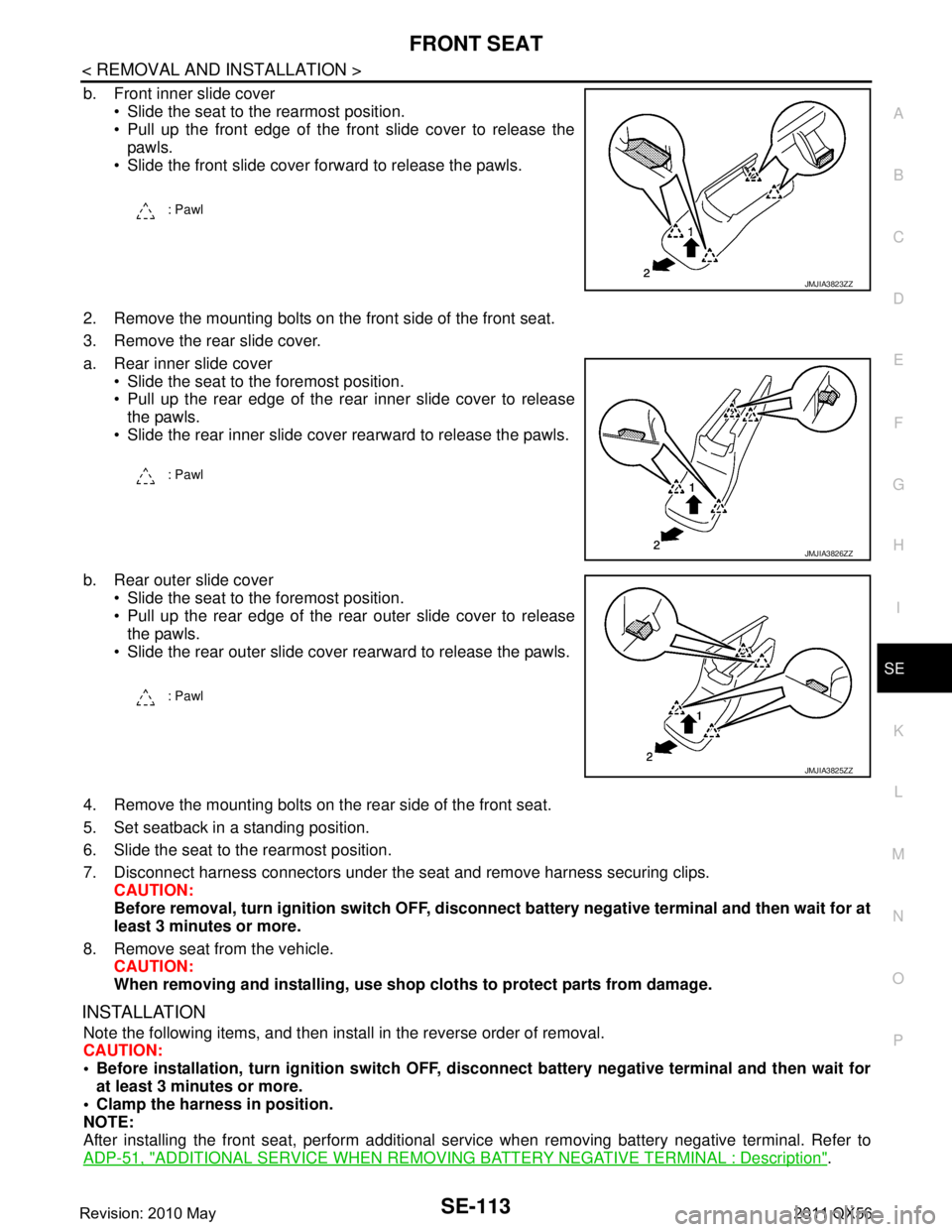
FRONT SEATSE-113
< REMOVAL AND INSTALLATION >
C
DE
F
G H
I
K L
M A
B
SE
N
O P
b. Front inner slide cover Slide the seat to the rearmost position.
Pull up the front edge of the front slide cover to release thepawls.
Slide the front slide cover forward to release the pawls.
2. Remove the mounting bolts on the front side of the front seat.
3. Remove the rear slide cover.
a. Rear inner slide cover Slide the seat to the foremost position.
Pull up the rear edge of the rear inner slide cover to releasethe pawls.
Slide the rear inner slide cover rearward to release the pawls.
b. Rear outer slide cover Slide the seat to the foremost position.
Pull up the rear edge of the rear outer slide cover to releasethe pawls.
Slide the rear outer slide cover rearward to release the pawls.
4. Remove the mounting bolts on t he rear side of the front seat.
5. Set seatback in a standing position.
6. Slide the seat to the rearmost position.
7. Disconnect harness connectors under the seat and remove harness securing clips. CAUTION:
Before removal, turn ignition sw itch OFF, disconnect battery negative terminal and then wait for at
least 3 minutes or more.
8. Remove seat from the vehicle. CAUTION:
When removing and installing, use shop cloths to protect parts from damage.
INSTALLATION
Note the following items, and then install in the reverse order of removal.
CAUTION:
Before installation, turn ignition switch OFF, disconnect battery ne gative terminal and then wait for
at least 3 minutes or more.
Clamp the harness in position.
NOTE:
After installing the front seat, perform additional serv ice when removing battery negative terminal. Refer to
ADP-51, "
ADDITIONAL SERVICE WHEN REMOVING BATTERY NEGATIVE TERMINAL : Description".
: Pawl
JMJIA3823ZZ
: Pawl
JMJIA3826ZZ
: Pawl
JMJIA3825ZZ
Revision: 2010 May2011 QX56
Page 4609 of 5598

SEC-2
WIRING DIAGRAM .....................................31
SECURITY CONTROL SYSTEM .................... ...31
Wiring Diagram .................................................... ...31
BASIC INSPECTION ...................................48
DIAGNOSIS AND REPAIR WORK FLOW ..... ...48
Work Flow ............................................................ ...48
ADDITIONAL SERVICE WHEN REPLACING
CONTROL UNIT ................................................
51
ECM ........................................................................ ...51
ECM : Description ...................................................51
ECM : Work Procedure ...........................................51
BCM ........................................................................ ...51
BCM : Description ...................................................51
BCM : Work Procedure ...........................................51
DTC/CIRCUIT DIAGNOSIS ...................... ...53
P1610 LOCK MODE ....................................... ...53
Description ........................................................... ...53
DTC Logic ...............................................................53
Diagnosis Procedure ..............................................53
P1611 ID DISCORD, IMMU-ECM ......................54
DTC Logic ............................................................ ...54
Diagnosis Procedure ..............................................54
P1612 CHAIN OF ECM-IMMU ...........................55
DTC Logic ............................................................ ...55
Diagnosis Procedure ..............................................55
P1614 CHAIN OF IMMU-KEY ...........................56
DTC Logic ............................................................ ...56
Diagnosis Procedure ..............................................56
B2192 ID DISCORD, IMMU-ECM ......................60
DTC Logic ............................................................ ...60
Diagnosis Procedure ..............................................60
B2193 CHAIN OF ECM-IMMU ...........................61
DTC Logic ............................................................ ...61
Diagnosis Procedure ..............................................61
B2195 ANTI-SCANNING ...................................62
DTC Logic ............................................................ ...62
Diagnosis Procedure ..............................................62
B2196 DONGLE UNIT .......................................63
Description ........................................................... ...63
DTC Logic ...............................................................63
Diagnosis Procedure ..............................................63
B2198 NATS ANTENNA AMP. .........................65
DTC Logic ............................................................ ...65
Diagnosis Procedure ..............................................65
B2013 STEERING LOCK UNIT .........................69
DTC Logic ............................................................ ...69
Diagnosis Procedure ............................................ ...69
B2014 CHAIN OF STRG-IMMU ........................70
DTC Logic ............................................................ ...70
Diagnosis Procedure ...............................................70
B2555 STOP LAMP ...........................................73
DTC Logic ............................................................ ...73
Diagnosis Procedure ...............................................73
Component Inspection ............................................74
B2556 PUSH-BUTTON IGNITION SWITCH .....76
DTC Logic ............................................................ ...76
Diagnosis Procedure ...............................................76
Component Inspection ............................................77
B2557 VEHICLE SPEED ...................................78
DTC Logic ............................................................ ...78
Diagnosis Procedure ...............................................78
B2601 SHIFT POSITION ...................................79
DTC Logic ............................................................ ...79
Diagnosis Procedure ...............................................79
Component Inspection ............................................81
B2602 SHIFT POSITION ...................................82
DTC Logic ............................................................ ...82
Diagnosis Procedure ...............................................82
Component Inspection ............................................83
B2603 SHIFT POSITION ...................................85
DTC Logic ............................................................ ...85
Diagnosis Procedure ...............................................85
Component Inspection ............................................87
B2604 SHIFT POSITION ...................................89
DTC Logic ............................................................ ...89
Diagnosis Procedure ...............................................89
B2605 SHIFT POSITION ...................................91
DTC Logic ............................................................ ...91
Diagnosis Procedure ...............................................91
B2608 STARTER RELAY .................................93
DTC Logic ............................................................ ...93
Diagnosis Procedure ...............................................93
B2609 STEERING STATUS ..............................95
DTC Logic ............................................................ ...95
Diagnosis Procedure ...............................................95
B260B STEERING LOCK UNIT ........................98
DTC Logic ............................................................ ...98
Diagnosis Procedure ...............................................98
B260C STEERING LOCK UNIT ........................99
DTC Logic ............................................................ ...99
Diagnosis Procedure ...............................................99
B260D STEERING LOCK UNIT .......................100
DTC Logic ............................................................ .100
Diagnosis Procedure .............................................100
Revision: 2010 May2011 QX56
Page 4612 of 5598
![INFINITI QX56 2011 Factory Service Manual
PRECAUTIONSSEC-5
< PRECAUTION > [WITH INTELLIGENT KEY SYSTEM]
C
D
E
F
G H
I
J
L
M A
B
SEC
N
O P
PRECAUTION
PRECAUTIONS
Precaution for Supplemental Restraint System (SRS) "AIR BAG" and "SEAT BELT
PR INFINITI QX56 2011 Factory Service Manual
PRECAUTIONSSEC-5
< PRECAUTION > [WITH INTELLIGENT KEY SYSTEM]
C
D
E
F
G H
I
J
L
M A
B
SEC
N
O P
PRECAUTION
PRECAUTIONS
Precaution for Supplemental Restraint System (SRS) "AIR BAG" and "SEAT BELT
PR](/manual-img/42/57033/w960_57033-4611.png)
PRECAUTIONSSEC-5
< PRECAUTION > [WITH INTELLIGENT KEY SYSTEM]
C
D
E
F
G H
I
J
L
M A
B
SEC
N
O P
PRECAUTION
PRECAUTIONS
Precaution for Supplemental Restraint System (SRS) "AIR BAG" and "SEAT BELT
PRE-TENSIONER"
INFOID:0000000006226148
The Supplemental Restraint System such as “A IR BAG” and “SEAT BELT PRE-TENSIONER”, used along
with a front seat belt, helps to reduce the risk or severi ty of injury to the driver and front passenger for certain
types of collision. This system includes seat belt switch inputs and dual stage front air bag modules. The SRS
system uses the seat belt switches to determine the front air bag deployment, and may only deploy one front
air bag, depending on the severity of a collision and whether the front occupants are belted or unbelted.
Information necessary to service the system safely is included in the “SRS AIR BAG” and “SEAT BELT” of this
Service Manual.
WARNING:
• To avoid rendering the SRS inoper ative, which could increase the risk of personal injury or death in
the event of a collision that would result in air ba g inflation, all maintenance must be performed by
an authorized NISSAN/INFINITI dealer.
Improper maintenance, including in correct removal and installation of the SRS, can lead to personal
injury caused by unintentional act ivation of the system. For removal of Spiral Cable and Air Bag
Module, see the “SRS AIR BAG”.
Do not use electrical test equipm ent on any circuit related to the SRS unless instructed to in this
Service Manual. SRS wiring harnesses can be identi fied by yellow and/or orange harnesses or har-
ness connectors.
PRECAUTIONS WHEN USING POWER TOOLS (AIR OR ELECTRIC) AND HAMMERS
WARNING:
When working near the Air Bag Diagnosis Sensor Unit or other Air Bag System sensors with the
ignition ON or engine running, DO NOT use air or electric power tools or strike near the sensor(s)
with a hammer. Heavy vibration could activate the sensor(s) and deploy the air bag(s), possibly
causing serious injury.
When using air or electric power tools or hammers , always switch the ignition OFF, disconnect the
battery, and wait at least 3 minutes before performing any service.
Precaution Necessary for Steering Wh eel Rotation after Battery Disconnect
INFOID:0000000006226149
NOTE:
Before removing and installing any control units, first tu rn the push-button ignition switch to the LOCK posi-
tion, then disconnect both battery cables.
After finishing work, confirm that all control unit connectors are connected properly, then re-connect both
battery cables.
Always use CONSULT-III to perform self-diagnosis as a part of each function inspection after finishing work.
If a DTC is detected, perform trouble diagnos is according to self-diagnosis results.
For vehicle with steering lock unit, if the battery is disconnected or discharged, the steering wheel will lock and
cannot be turned.
If turning the steering wheel is required with the batte ry disconnected or discharged, follow the operation pro-
cedure below before starting the repair operation.
OPERATION PROCEDURE
1. Connect both battery cables. NOTE:
Supply power using jumper cables if battery is discharged.
2. Turn the push-button ignition switch to ACC position. (At this time, the steering lock will be released.)
3. Disconnect both battery cables. The steering lock wil l remain released with both battery cables discon-
nected and the steering wheel can be turned.
4. Perform the necessary repair operation.
Revision: 2010 May2011 QX56